Plowing a firebreak near the village
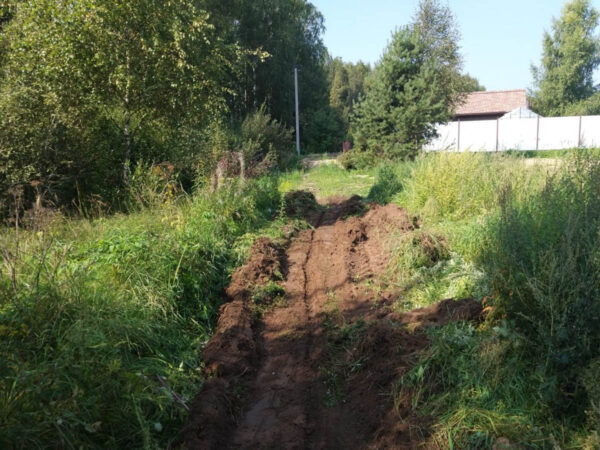
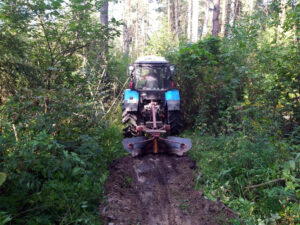
We carry out plowing operations around populated areas and forests for fire prevention purposes. The process involves the use of a tractor and a specialized forest plow to create a firebreak of exposed soil. The plow cuts through the sod and plant roots, exposing the infertile soil layer, while the sod is turned up on the sides of the furrow. This method helps prevent the spread of the most common types of fires—ground fires.
The establishment of firebreaks is a periodic measure. A firebreak may last for several years but will eventually become overgrown, requiring the procedure to be repeated. The width of the firebreak depends on the power of the tractor and the model of the plow used. We use not only symmetrical forest plows but also trenching plows for deep tilling. These plows can cut and turn over large sections of soil, rendering the surface neutral and unable to transmit ground fires.
Fire safety works are carried out on the instructions of municipalities and private organizations that are naturally interested in fire safety. Burning grass near or in the forest during a drought can turn into a forest fire, which is very dangerous.
Firebreak plowing is carried out by forestry plow with a tractor of adequate power.

Plowing a firebreak near the village
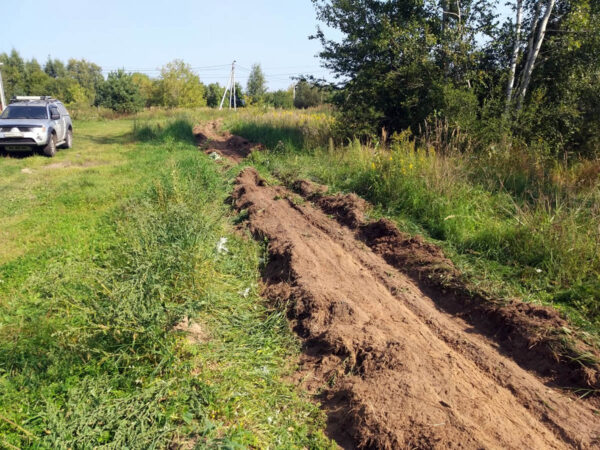
Checking the quality of firebreak plowing
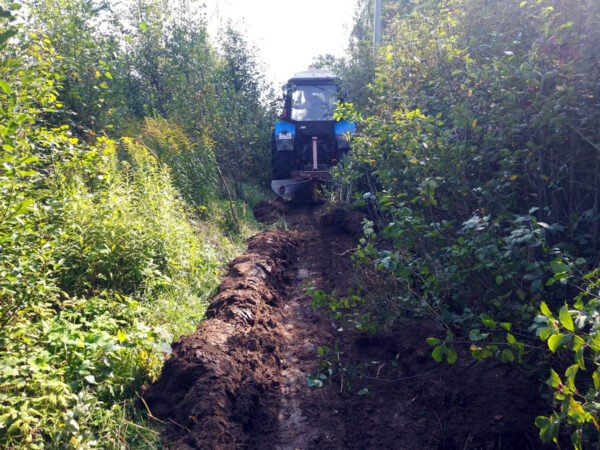
Tractor working with a forestry plow
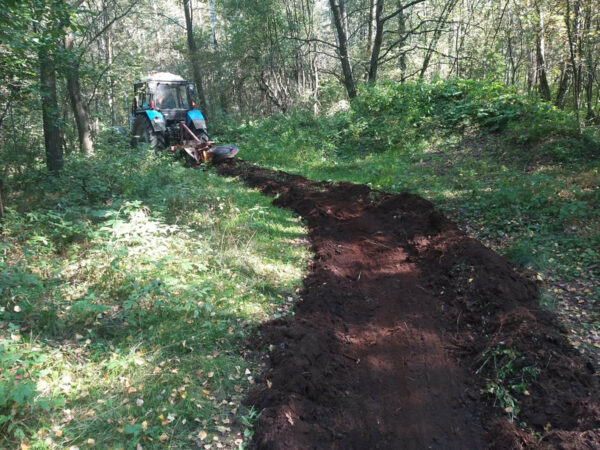
Plowing firebreaks in the forest
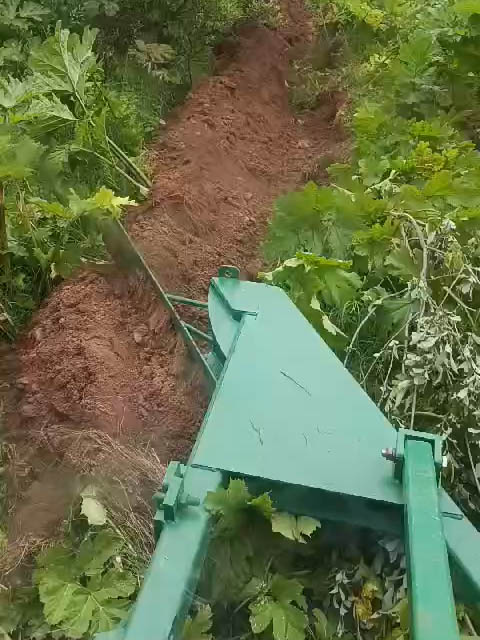
Plowing firebreaks with a plantage plow
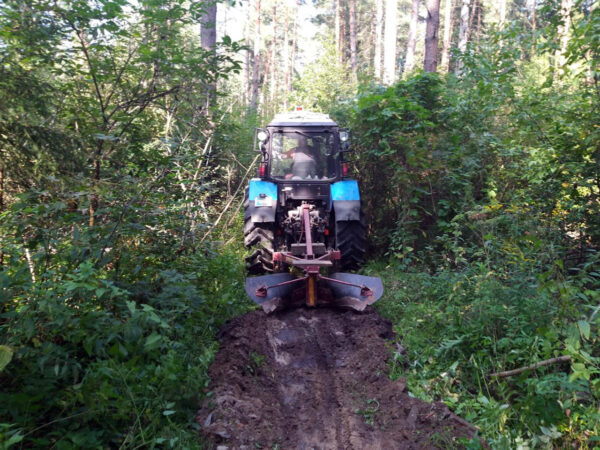
Plowing firebreaks to prevent ground fires in a forest
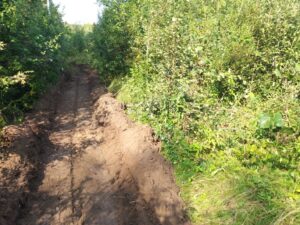
To protect villages or settlements from ground fires, firebreaks are commonly used. We receive and adjust the firebreak specifications, preparing the tractor and forest plow accordingly. The unique feature of the forest plow is its ability to dig to a specified depth, clearing plant debris from the furrow to its sides, and exposing a soil layer free of sod, grass, moss, and shrubs. This process creates two ridges of overturned sod.
The trajectory of the tractor and plow forms a protective strip that separates the settlement from the forest, fields, or meadows. As a result, the risk of ground fire spreading is reduced, localizing potential fire transmission points and facilitating fire suppression efforts. The plowing of firebreaks is one of the simplest methods for ensuring fire safety in populated areas.
Mineralized firebreaks are also used to protect agricultural facilities—fields, meadows, and farms—from the spread of ground fires. Vegetation can become dry and flammable by autumn and spring, increasing the fire hazard. During rainy or wet conditions, this danger is reduced. By plowing with a forest plow, we can protect buildings on agricultural sites and fields from fire.
Globally, forests are divided into compartments by clearings ranging from 10 to 50 meters in width. A forest compartment is the primary unit of forest management and fire safety. Firebreaks are established along the boundaries of these compartments, as well as within them, through forest clearing, which removes fallen branches and dry, deadwood.
Plowing firebreaks helps protect forested areas from ground fires, which are a significant threat. If a ground fire occurs, it can destroy the understory and, under certain conditions, escalate into a crown fire—especially during hot, dry weather in coniferous forests. Crown fires are particularly dangerous in windy conditions and can completely destroy agricultural buildings and homes in forest-adjacent settlements.
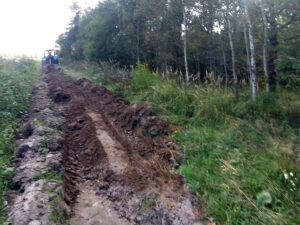
The creation of firebreaks is planned both along forest boundaries and within the forest itself. Forests cleared of deadwood are more resilient to ground fires. If sections of the forest are separated by mineralized firebreaks, the fire will not spread from one section to another. Clearing the forest of deadwood also reduces fire hazards, as ground fires in forests filled with windfallen trees pose a significantly greater threat than those occurring in open fields.
Firebreaks can only be established if there is no peat beneath the sod layer. Plowing over peat, on the contrary, dries it out and makes it more vulnerable to ground fires during droughts. Therefore, in areas with peat soils, drainage ditches are necessary for moisture control. If the plow exposes a subsoil layer of sand or clay, such a firebreak can last 2-3 years with a guarantee. Regulations stipulate that firebreak systems, including ditches and firebreaks, must be updated when they become 30% overgrown.
The maintenance of mineralized firebreaks is a set of operations that extend the lifespan of fire barriers against surface wildfires. It is a preventive fire protection measure that allows the restoration of mineralized firebreaks.
Clearing fallen branches, trees, and combustible materials
This involves the removal of debris such as branches and trees that have fallen across the firebreak, as well as any other combustible materials that may fuel a fire.
Restoration of the mineralized firebreak
This is done through shallow plowing along the existing firebreak to restore its protective qualities, especially when vegetation starts to grow. Shallow plowing is less costly compared to deep plowing.
Treatment of the firebreak with general-purpose herbicides
Herbicide application prevents vegetation from growing back on the mineralized strip, maintaining its effectiveness as a firebreak.
The maintenance of mineralized firebreaks, including branch and tree removal, shallow plowing, and herbicide application, is a periodic activity in areas where firebreak restoration is necessary. These operations are more cost-effective compared to deep plowing of previously uncultivated land.
How do we operate? When involved in land development, we prepare a Territory Planning Project (TPP) and a Work Production Plan (WPP). In civil engineering, this is based on the dendrological plan of the area, known as the dendroplan.
A dendroplan allows for the management of the entire tree population on the site and provides authorization for the removal of trees that obstruct development, including those within the construction footprint. It also helps identify protected vegetation that cannot be removed. Then we clear a land from vegetation, make levelling and drainage system or/and irrigation.
We can also prepare a Fire Safety Passport for the site, which includes evacuation plans, water supply routes, and access roads for firefighting equipment. We plan and construct water collection points and access roads to ponds and other water reservoirs suitable for fire suppression, taking into account reserve capacities.
– Ensuring optimal fire safety conditions in forests.
– Preventing the occurrence of wildfires and fires in forests.
– Establishing conditions for early detection of forest fires.
– Preventing the spread of fires in specific forest areas to minimize damage and/or create conditions for fire suppression with sufficient resources.
– Protecting valuable forest areas, natural objects, settlements, and infrastructure from the threat of wildfires.
– Creating conditions for the timely arrival of firefighting forces and resources at fire locations for suppression.
– Establishing favorable conditions for effective fire suppression, taking into account local specifics, and reducing damage to forests and overall fire damage.
– Wildland-Urban Interface (WUI): areas where residential homes and businesses are built near combustible vegetation, such as forests, shrubs, prairies, and fields.
– Fuel Reduction: actions aimed at reducing or eliminating vegetation in an area, typically around buildings, as a preventive measure before wildfires occur.
– Fire-Retardant Wood Treatment: wood treated with chemicals for outdoor use to reduce flammability in construction.
– Dry Hydrants: stationary pipes installed without pressure in lakes, ponds, or streams in remote areas, providing access to water for firefighting.
– Fire Lookout Tower: a tower used for observing and reporting wildfires.
– Fire-Resistant Construction: the design and construction of buildings capable of withstanding fires.
– Wildfire Suppression: all activities related to extinguishing or containing a wildfire.
– Mitigation: actions aimed at reducing the impact of wildfires by lowering the risk and vulnerability of the area to fire.
– Forest Fire Resilience: the ability of forests to recover quickly after a natural disaster.
– Initial Attack: the first actions taken by emergency services upon arrival at a wildfire to protect lives and property and prevent the spread of fire.
– Defensible Space: an area around a building that has been cleared of flammable materials through landscaping techniques.